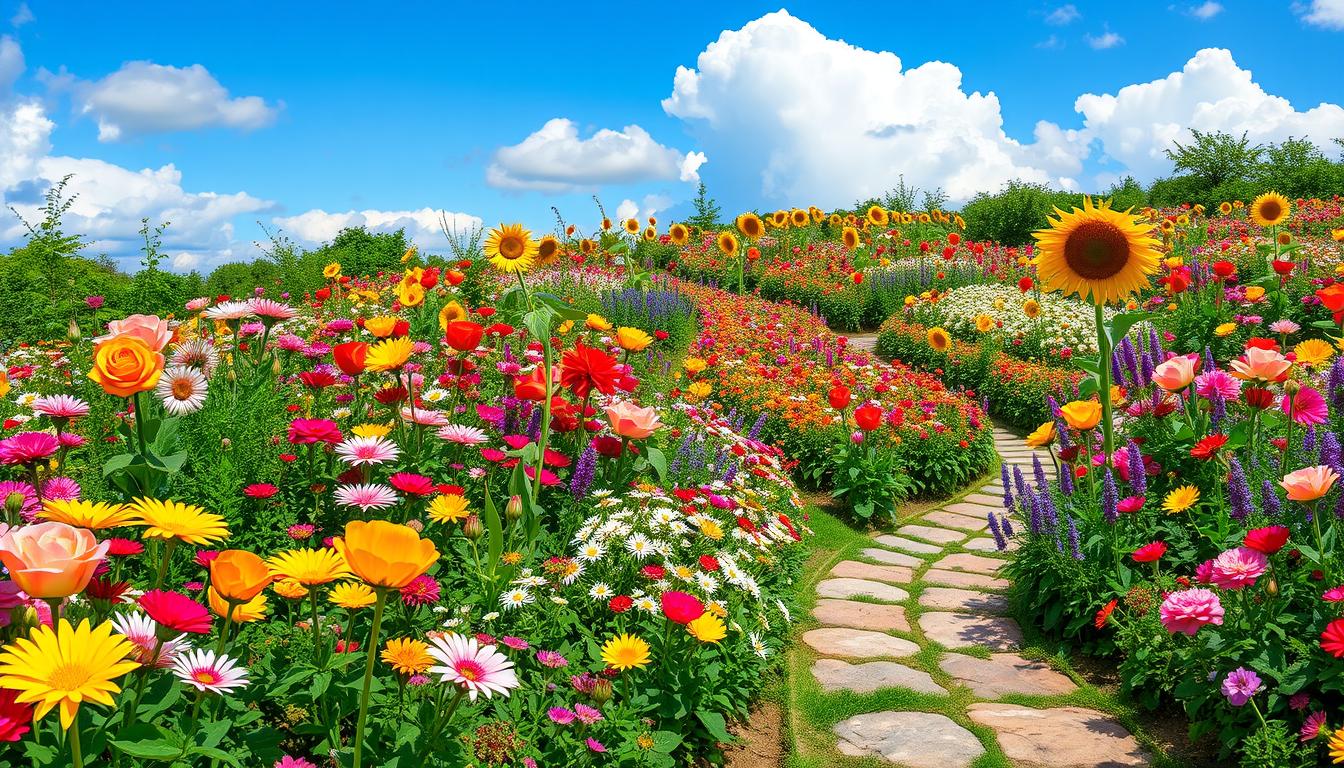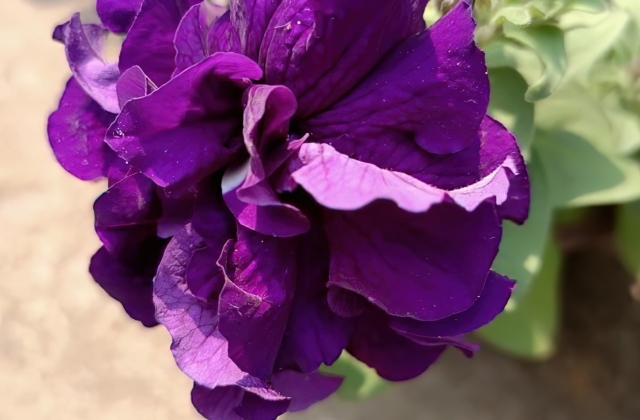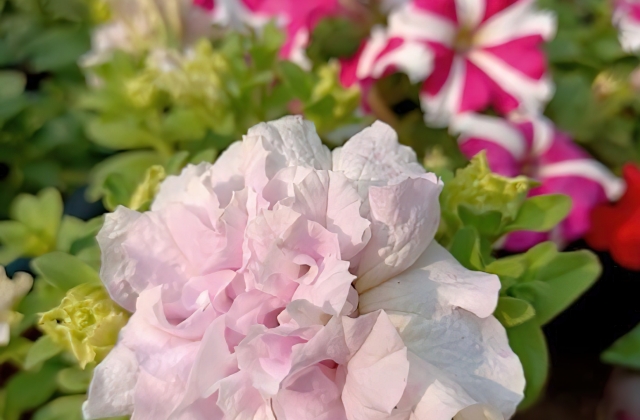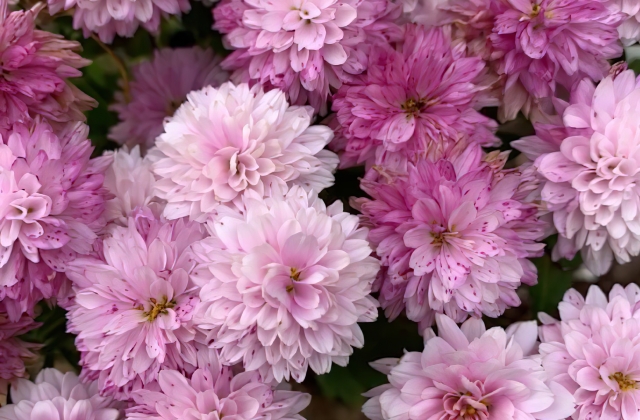Create a Stunning Flower Garden in Your Yard
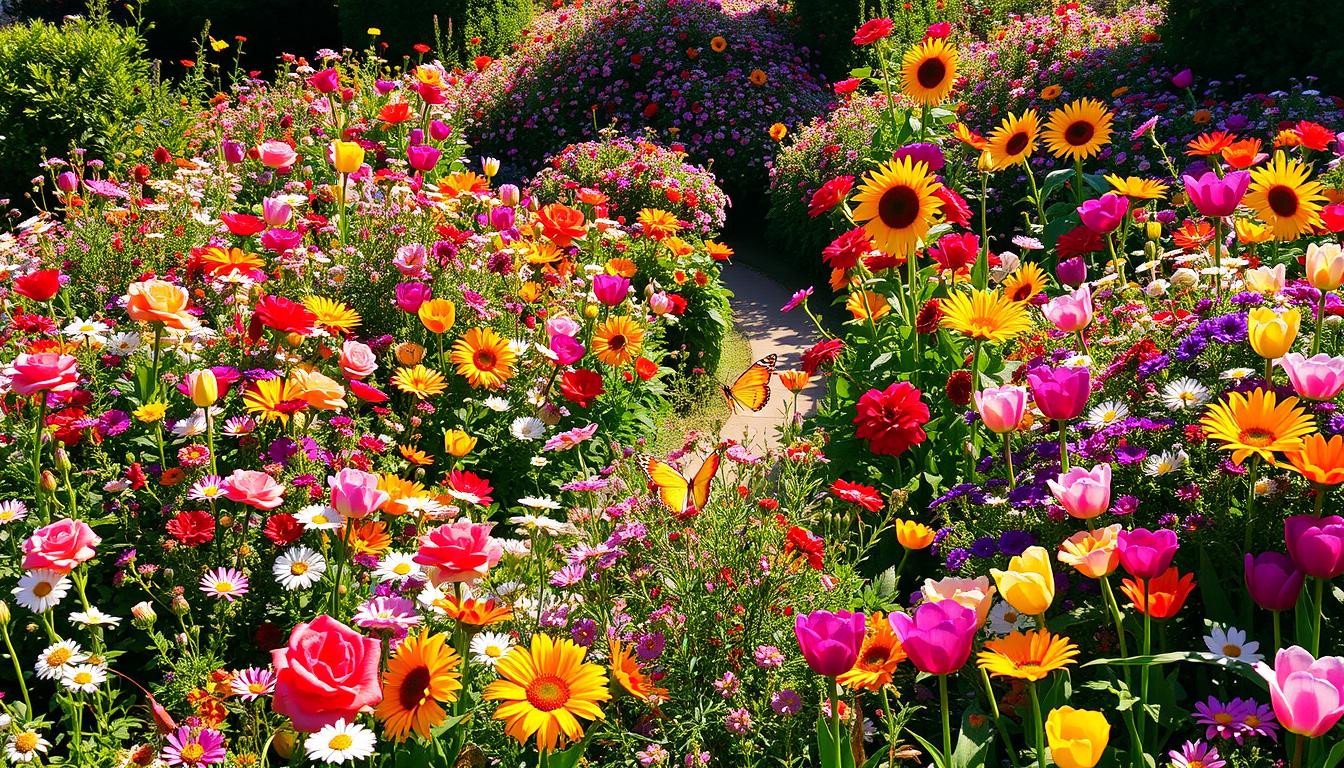
Ever thought about how changing your outdoor space could boost your home’s look and your mood? A stunning flower garden in your yard does more than just look good. It becomes a haven for pollinators, supports nature, and makes your home stand out. We’ll share key gardening tips to help you every step of the way, from picking the best spot to keeping your garden thriving. Whether you’re new to gardening or have been doing it for years, we’ve got you covered to create a garden that shines year-round.
Key Takeaways
- Flowers typically need 6 to 8 hours of sunlight daily for optimal growth.
- Well-draining, loamy soil is essential for healthy blooms.
- Conduct soil tests to determine pH levels and necessary amendments.
- Incorporating mulch retains moisture, prevents weeds, and insulates roots.
- Consider mature plant sizes for appropriate spacing in your flower bed.
- Raised flower beds can improve accessibility and soil conditions.
Benefits of a Flower Garden
A vibrant flower garden brings many benefits, both for looks and the environment. It makes your outdoor space look beautiful and helps support important pollinators. By creating a garden, you make your home more attractive and help the ecosystem.
Curb Appeal and Aesthetic Value
A flower garden boosts your home’s curb appeal right away. It makes your home look welcoming and can even increase its value. When picking plants, choose native ones that do well in your area. They need less care and help your garden thrive.
Supporting Pollinators and Biodiversity
Plants that attract pollinators are key to a healthy ecosystem. Flowers give insects like bees and butterflies the food they need. Each bite of food we eat depends on these pollinators. By planting different types of flowers, you help these vital creatures and improve the health of your garden and the environment.
Choosing the Right Location
Finding the perfect spot for your flower garden is key to its success. Sunlight and soil drainage are very important. With the right spot, your plants will grow well and make your outdoor area more beautiful.
Assessing Sunlight Requirements
Most flowers need six to eight hours of sunlight each day. If your garden gets less sun, pick plants that like partial shade. Knowing how much sun your garden gets helps you choose the right flowers.
Evaluating Drainage and Soil Quality
Good soil drainage is crucial. If water stays in one spot, it can harm your plants. Make sure water drains well in your chosen area. A spot that drains well means less work for you.
Before you start planting, test your soil. This tells you about the soil’s pH and what nutrients plants need. Most flowers do best in soils with a pH of 6 to 7. Different plants need different soil types, so think about this when choosing.
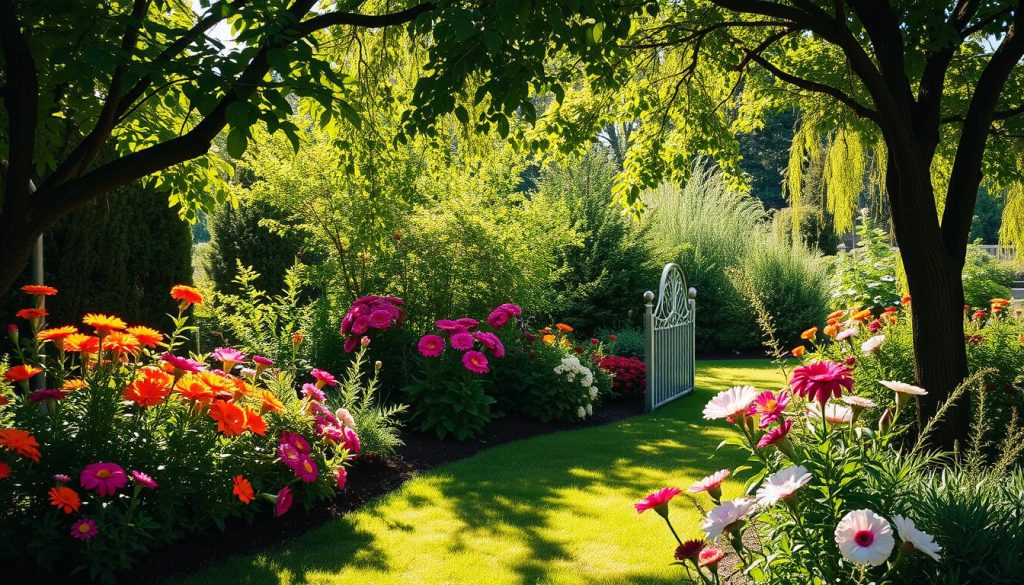
Understanding Your Soil
Knowing about your soil is key to a thriving flower garden. A soil test reveals the pH levels and nutrient levels. This info helps pick the right plants and improve soil quality.
Conducting a Soil Test
A soil test tells you about your soil type—sandy, clay, silty, or loamy. Each type has its own traits:
- Sandy soil drains fast and needs regular watering but suits drought-resistant plants.
- Clay soil is nutrient-rich and holds moisture well but can get hard to work with.
- Silty soil is fertile and keeps moisture balanced, great for many plants.
- Loamy soil, a mix of sand, silt, and clay, is often considered ideal for gardening.
Test your soil every 3–5 years to keep it perfect for your plants. This helps spot nutrient shortages or surpluses like nitrogen, phosphorus, and potassium, which are vital for plant health.
Improving Soil Composition
A soil test shows how to fix soil issues. You can add things like compost or organic fertilizers to improve it. Tilling the soil helps with air flow and drainage. For clay soils, adding organic stuff is key to stop compaction and help roots grow well.
Regular checks and tweaks to your soil create a better garden environment. Adding nutrient-rich stuff after harvest is key for plant health and growth.
Designing Your Flower Garden
Creating a flower garden design that reflects your style and suits your plants takes careful planning. The way you arrange plants is key to making your garden look good and work well. Using flowing shapes instead of straight lines makes your garden more lively and welcoming.
Creating a Layout and Shape
Try putting your plants in blocks or drifts instead of just placing them anywhere. This makes your garden look better and feel connected. Using odd numbers like three or five for plant groups looks nicer and balances your garden. Watching how your garden changes with the seasons can show you where you need more color or to tweak your design.
Considering Plant Groupings and Spacing
Getting the spacing right is crucial for healthy plants and a great look. Start by putting plants that bloom at different times together. This keeps your garden looking good all year. Putting smaller plants close together makes your garden look fuller and cuts down on the need for pruning. Choosing plants that do well makes your design easier and keeps your garden looking great.
Wide paths between beds make it easy to get around and protect your plants. Remember the basics of flower garden design. Look at botanical gardens, join gardening clubs, and check out Pinterest for ideas to improve your garden.
| Design Element | Considerations |
|---|---|
| Layout | Opt for flowing shapes and avoid rigid lines |
| Groupings | Use odd-numbered clumps (3, 5, or 7) for visual harmony |
| Spacing | Keep plants close for density; allow for wide paths |
| Plant Palette | Restrict to high-performing species for unity |
Best Plants for Your Flower Garden
Choosing the right flowers is key to a beautiful and healthy garden. Flowering annuals and perennials each bring unique beauty and benefits. Adding native pollinator plants can attract important wildlife to your garden. This knowledge helps you pick the best plants for your garden.
Flowering Annuals vs. Perennials
Flowering annuals are known for their bright colors and changing looks with the seasons. They grow well in zones 3-9, adding joy with their variety of colors like reds, yellows, and purples. Some top annuals are:
- Sunflowers – Can grow 3-16 feet tall and need little care.
- Impatiens – Reach 18-60 inches tall, perfect for shady spots.
- Nasturtiums – Their vines can spread up to 10 feet.
Perennials, on the other hand, offer lasting beauty, coming back year after year. They’re great for busy gardeners because they need little care. Some top perennials are:
- Coneflowers – Attract butterflies and grow best in full sun.
- Dahlias – Come in many shapes and colors, adding interest to your garden.
- Bearded Iris – Easy to care for and bloom in various colors.
Attracting Pollinators with Native Plants
Adding native pollinator plants to your garden boosts local wildlife. These plants need less care and fit well with your local climate. For instance:
| Plant Name | Bloom Period | Height | Attracts |
|---|---|---|---|
| Bee Balm | Summer to Fall | 36 inches | Bees, Hummingbirds |
| Aster | Late Summer to Fall | 12-36 inches | Butterflies |
| Helenium | Mid-Summer to Fall | 24-36 inches | Pollinators |
Using a mix of the best flowering plants, annuals, perennials, and native pollinator plants makes your garden vibrant and full of life. It attracts beauty and beneficial insects.
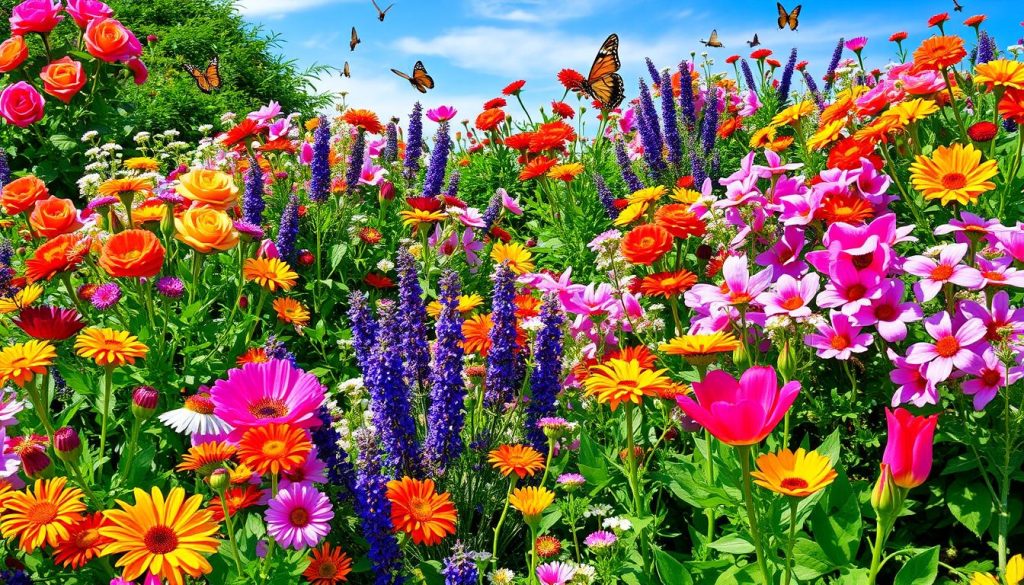
How to Make a Flower Bed
Creating a flower bed needs careful planning and prep for your plants to thrive. Start by removing grass and unwanted plants. Then, prepare the soil for your flowers.
Removing Existing Vegetation
To make a flower bed, first remove grass and unwanted plants. You can do this in a few ways:
- Using a shovel or spade to dig out the grass manually.
- Covering the area with cardboard or newspaper, letting it smother the grass for months.
- Employing landscape fabric or mulch to block weeds.
Make sure to remove all roots to stop regrowth. This clears the area and helps your flowers grow better.
Preparing the Soil for Planting
After removing grass, focus on soil prep for healthy plants. Dig the soil to 12 inches deep, or 18 inches for better drainage and root growth.
Add organic matter like compost to the soil. Spread 2 to 3 inches of compost and mix it in well. This boosts soil nutrition, helps microbes, and keeps moisture in, key for healthy flowers.
To keep weeds away, use a thick mulch or weed-and-feed products. Adding organic stuff regularly keeps the soil rich and your flowers blooming.
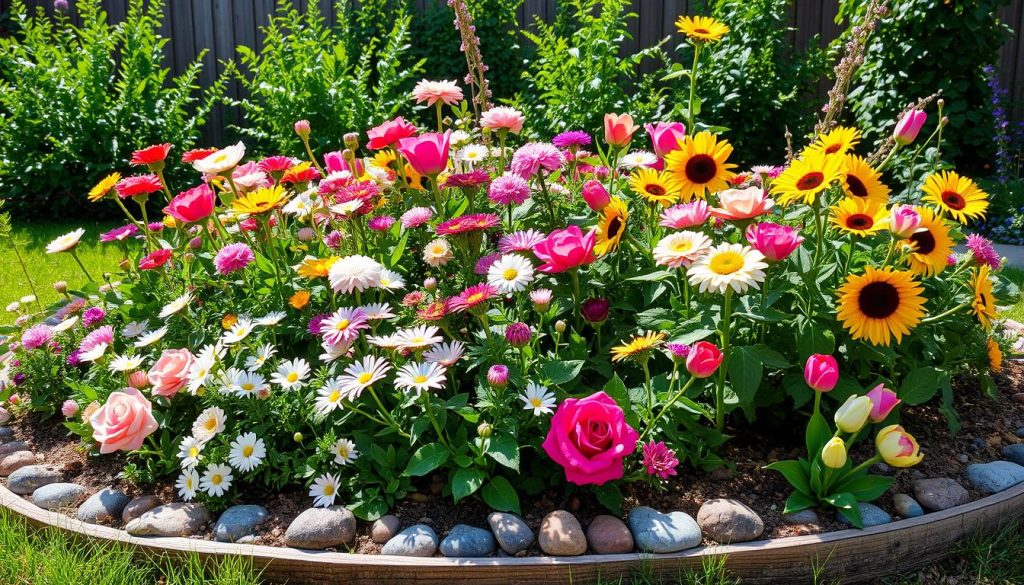
Flower Garden Planting Techniques
Successful flower gardening starts with knowing how to plant correctly. Make sure to leave enough space between plants for good airflow and growth. Also, make sure roots can dig deep for strong plants. These tips can greatly improve your garden’s health.
Spacing and Depth Considerations
How you space your flowers is key to their success. The right distance depends on the type of flower. Here are some general guidelines for spacing:
| Plant Type | Recommended Spacing |
|---|---|
| Annuals | 6 to 12 inches apart |
| Perennials | 12 to 24 inches apart |
| Tall Plants | 18 to 36 inches apart |
Also, think about how deep to plant. Roots should be covered as much as they were in their pots. This helps them settle in better and prevents shock. So, if a plant came from a pot, make sure the soil level in the garden matches the pot’s.
Watering Immediately After Planting
Watering your plants right after planting is crucial. It helps the soil settle around the roots. This first drink of water is key for their health and growth. Keep the soil moist for the first few weeks to help your flowers thrive.
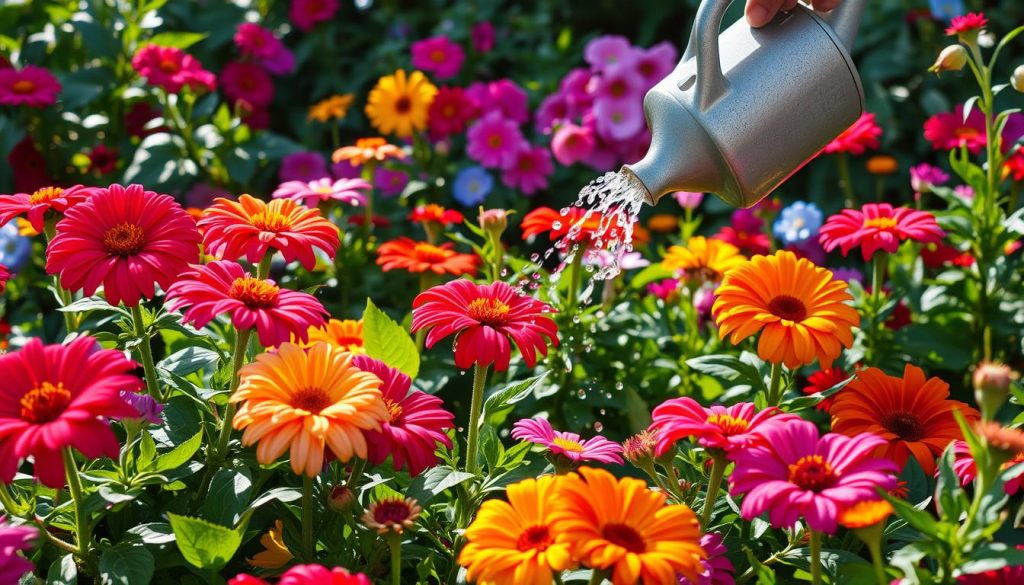
Maintaining Your Flower Garden
Keeping your flower garden in top shape is key to its beauty and health. A regular routine boosts your garden’s look and helps plants grow well. This includes following watering tips, controlling weeds, and fertilizing flowers correctly.
Watering and Irrigation Tips
Watering is vital for new and established flowers. Water them every other day to help roots grow strong. For plants that are already grown, watering once or twice a week is enough.
Watering in the early morning or evening is best to cut down on evaporation. Think about getting a drip irrigation system. It waters plants deeply but doesn’t overdo it, preventing diseases.
Weed Control Strategies
Weeds can take over your garden, taking nutrients and space from your flowers. Weeding regularly keeps your garden healthy. Set aside time each week for weeding and use tools like the CobraHead weeder to make it easier.
Putting down a 2 to 3-inch layer of mulch helps with weed control and keeps the soil moist. Mulch also looks good and can keep pests away, especially with cypress or cedar mulch.
Fertilizing for Optimal Growth
Fertilizing your flowers is crucial for a thriving garden. Test your soil every year to see what nutrients it needs. Many people don’t fertilize enough, but it’s important to do it regularly based on the test results.
Pruning in late winter and deadheading once a week helps flowers bloom better and stay healthy. This keeps your garden looking its best.
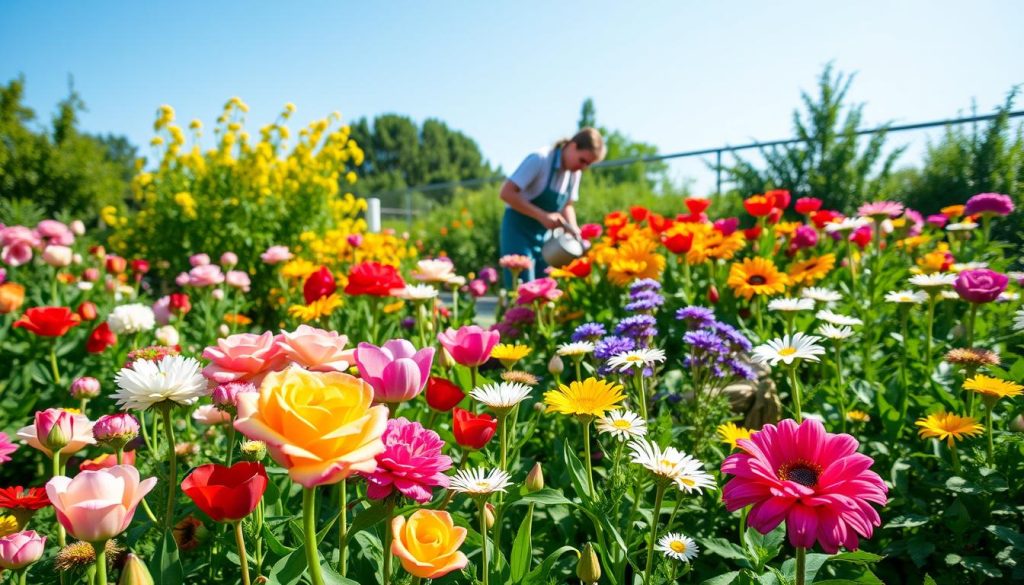
Dealing with Common Garden Pests
Gardening has its ups and downs, and dealing with pests is a big challenge. Every gardener will face problems with pests or diseases. It’s key to know how to identify pests to keep your garden healthy.
Identifying Pest Problems
Knowing the pests in your area and their signs is vital. Common pests include:
- Insects like aphids and beetles
- Slugs and mites that harm flowers
- Diseases from fungi, bacteria, or viruses
Watch for signs like leaves that look wrong, holes, or color changes. Knowing the usual pests in your area helps in controlling them early.
Natural Remedies and Prevention
Using natural pest control methods cuts down on chemicals. Here are ways to prevent pests:
- Feed the soil with organic stuff to make plants strong.
- Move your plants around every year to stop pests.
- Plant flowers that attract good bugs to help control pests.
- Use barriers, traps, and covers to keep pests away.
Check your garden often to spot problems early. Use things like garlic, pepper, and neem oil to keep pests away. For tough cases, remove pests by hand or use traps. Chemical sprays should be a last choice; choose gentle methods to keep your garden healthy.
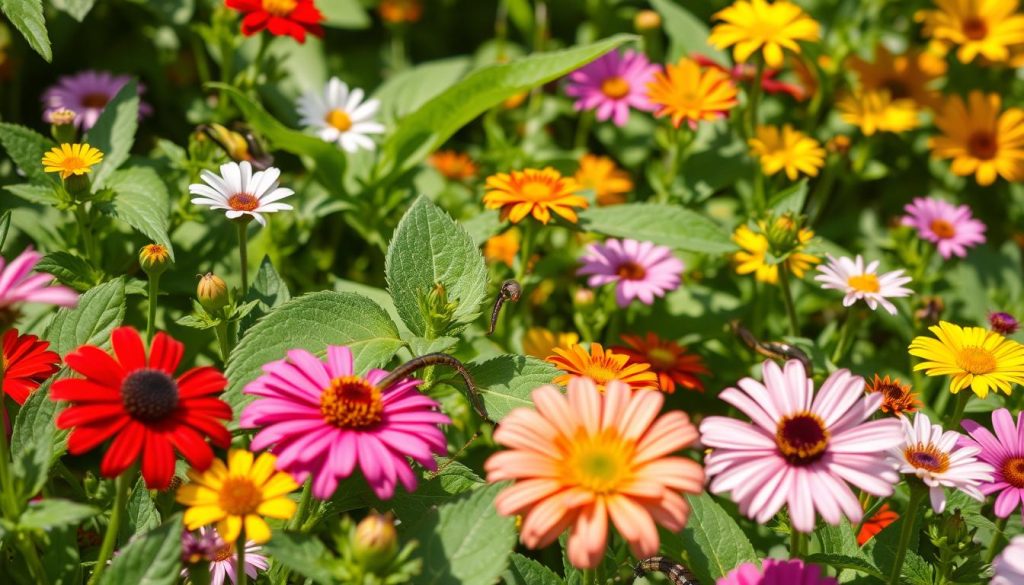
Focus on preventing pests and acting fast to keep your flower garden beautiful and pest-free.
Creating Seasonal Interest in Your Flower Garden
Adding seasonal interest to your flower garden makes it look great all year. By picking plants that bloom in different seasons, your garden stays beautiful. This plan makes your outdoor space more attractive and helps wildlife and your local ecosystem.
Choosing Plants for Year-Round Blooms
For flowers that bloom all year, mix perennials and annuals. Perennials come back every year and are often pricier. In spring, pansies, tulips, and daffodils brighten up your garden.
Summer brings marigolds and zinnias, plus perennials like iris and black-eyed Susan. For fall, asters and chrysanthemums add color. Evergreen plants like hollies and junipers keep your garden looking good in winter.
Planning for Succession Planting
Succession planting keeps your garden colorful and interesting. Group plants with the same sunlight and water needs. This makes caring for your garden easier.
Plant flowers that bloom at different times, so one group can follow another. A well-thought-out design ensures a smooth flow of colors through the seasons. Use different heights and textures to add depth and interest. Garden-planning apps can help you plan how plants will look together over time.
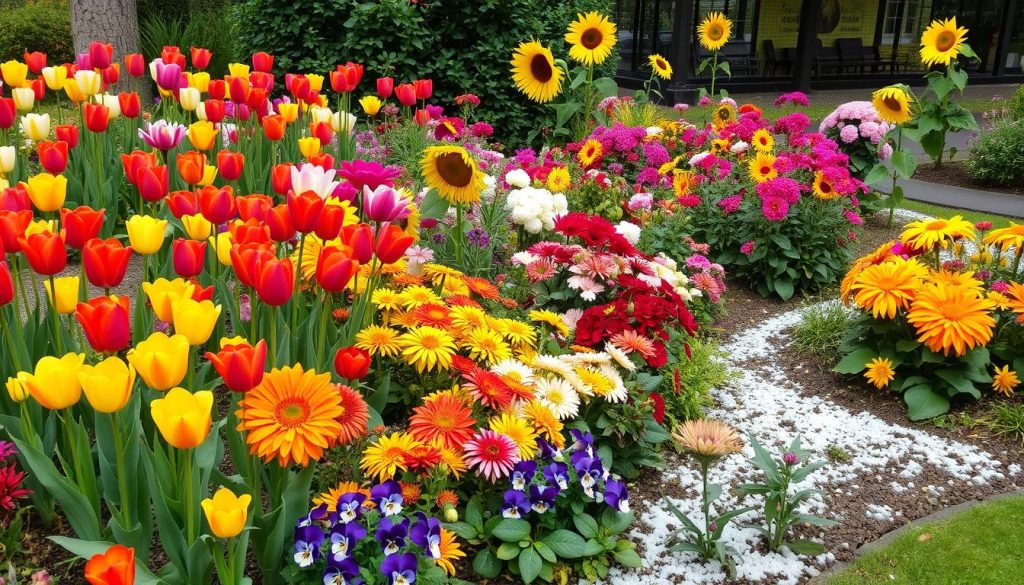
Exploring Floral Design Ideas
Creating a beautiful flower garden takes careful planning and a clear vision. Using floral design ideas can make your outdoor space look amazing. By adding focal points and textures, and picking a color palette for flowers, you can get a garden that looks great and feels lively.
Incorporating Focal Points and Textures
Focal points are key to catching the eye and adding interest to a flower garden. Use tall plants like echinacea or agapanthus to anchor your design. Add vibrant blooms, such as hydrangeas, for striking accents. Mixing textures with leaves, blooms, and branches keeps your design lively and interesting.
The glossy leaves of snowball viburnum look great with the light petals of delicate flowers. This mix of textures and colors adds depth to your garden.
Choosing a Color Palette
The colors you choose for your flowers set the mood and style of your garden. Pick a mix of colors to create a calm or lively feel. Deep purples and bright yellows together look amazing.
Trending palettes include cool tones like blues and greens with soft yellows. This gives your garden a fresh, modern look. Think about how colors work together in different seasons to keep your garden looking great all year.
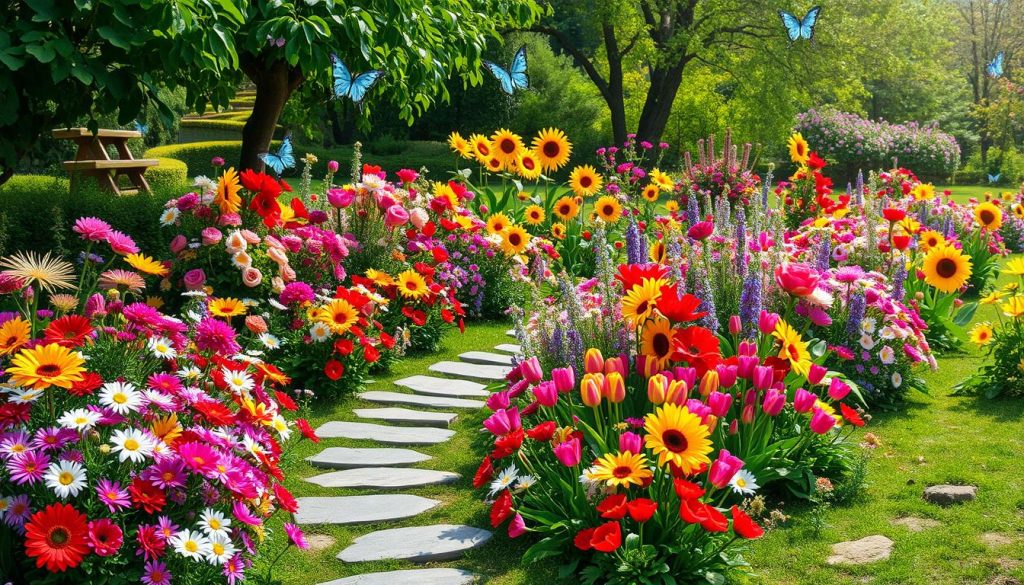
Transforming a Backyard with Flower Garden Ideas
Creating a beautiful backyard takes careful planning and creativity. Using smart garden ideas can greatly improve your outdoor space. Raised flower beds and hardscaping features are key to making your garden both accessible and attractive.
Utilizing Raised Beds for Accessibility
Raised flower beds are perfect for those who don’t want to bend or kneel while gardening. They can be made at different heights, helping everyone from kids to people with mobility issues. These beds also help with drainage and keep the soil warm, which is good for plants.
Incorporating Hardscaping Elements
Adding hardscaping like pathways and stone borders gives your garden a neat look. These features boost the beauty of your flower garden and are practical. Stones or pavers can lead visitors through your garden, showing off special spots while keeping the soil intact. A well-thought-out hardscape can also highlight your flowers, making their colors and textures stand out.
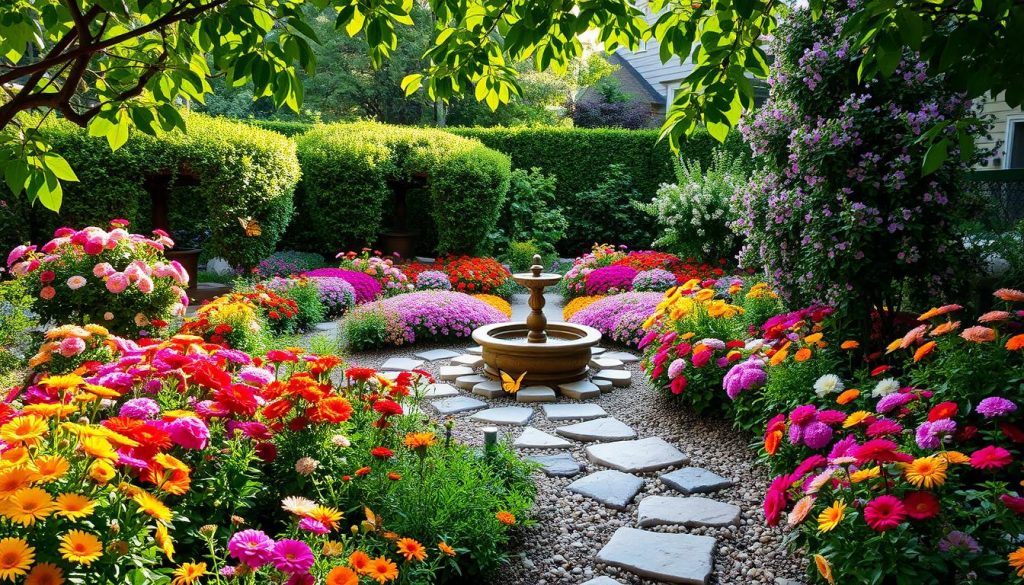
Conclusion
Creating a beautiful flower garden is a rewarding journey. It involves picking the right spot and knowing what your soil needs. By using the gardening tips in this article, you can make a garden that looks great and improves your health. Studies show that being around nature and green spaces helps your mental and physical health. Gardening is a great way to feel good.
Flowers are key to attracting bees and butterflies, which are important for the environment. Using native plants makes your garden stronger and easier to care for. It also uses less water. Taking good care of your plants, like watering and feeding them right, helps them grow well.
Gardening has many benefits, like helping you relax and being fun exercise. Using what you’ve learned can turn your backyard into a peaceful place. It brings joy and peace, helping your health and the planet.
